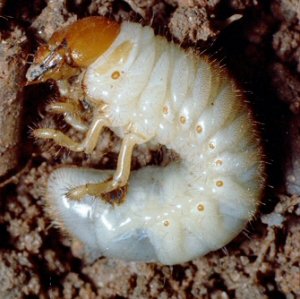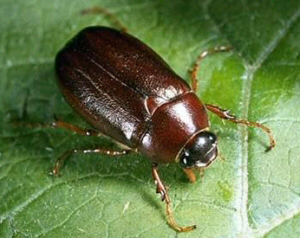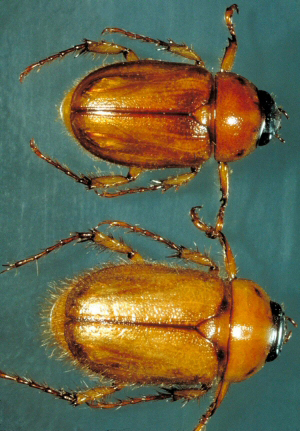White Grubs
 Scientific Name
Scientific Name
Cyclocephala and Phyllophaga spp.
Host
Larvae of both types of white grubs feed on dead organic matter and on the roots of most grasses and many other types of plants. Adult May/June beetles feed on the young, tender leaves of a variety of deciduous trees. Masked chafers are reported not to feed as adults.
 Symptoms
Symptoms
Aboveground symptoms of white grub damage are a, browning and dying of the grass in localized spots or in large irregular-shaped areas. Where infestations are heavy, the grass roots may be entirely eaten away and the turf may be rolled back like a carpet. Damage may be severe in September and October when the grubs are reaching maturity and the growth of bermudagrass is slowing down.
 Life Cycle
Life Cycle
May/June beetles have life cycles ranging from 1 -3 years depending on species and location. It appears that many species in Oklahoma have two-year life cycles. The adults emerge from the soil, some species as early as early April and others extending into mid-September. Adults of most species are most common in May and June. After mating, the females enter the soil and deposit about 50 eggs in small, earthen cells over a 1-3-week period. Larvae hatch 3-4 weeks later and begin feeding on dead organic matter, later moving to the roots of plants. In the fall, the larvae move deeper into the soil for the winter. The following spring they move back to the root zone to feed; most of their damage is done during this time. At maturity, they move deeper into the soil to pupate. Masked chafers have one year life cycles. They overwinter as third instar larvae deep in the soil. Larvae migrate upward during March and April and resume feeding until May, doing most of their damage during this period. They then move deeper in the soil for pupation. The adults emerge during June and July and mate. Females enter the soil and lay 10-30 eggs which hatch 2-3 weeks later. Annual white grubs are more likely to feed on dead organic matter than May/June beetle larvae and can develop on this diet alone.
Description
Adult May or June beetles (Phyllophaga spp.) are oblong, robust insects. There are many species in Oklahoma but most are shiny, reddish brown or dark brown, and 3/4 to 1 1/4 inches in length. They are often incorrectly referred to as "Junebugs." Adult masked chafers (Cyclocephala spp.) resemble May beetles but are smaller and yellow brown in color. The larvae are white, C-shaped grubs with distinct, brown heads and three pairs of legs near the front end. There are two rows of stout hairs (the radula) on the underside of the last abdominal segment of Phyllophaga spp. Cyclocephala spp. larvae (often called annual white grubs) have scattered, stout, hooked spines on the underside of the last abdominal segment.
Control
Please contact your local county extension office for current information.



